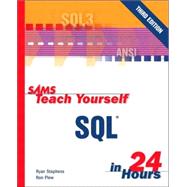
(NOTE: Each chapter concludes with a Summary, Q&A and Workshop.).
Introduction.
I. A SQL CONCEPTS OVERVIEW.
Hour 1. Welcome to the World of SQL.II. BUILDING YOUR DATABASE.
III. GETTING EFFECTIVE RESULTS FROM QUERIES.
IV. BUILDING SOPHISTICATED DATABASE QUERIES.
V. SQL PERFORMANCE TUNING.
VI. USING SQL TO MANAGE USERS AND SECURITY.
VII. SUMMARIZED DATA STRUCTURES.
VIII. APPLYING SQL FUNDAMENTALS IN TODAY'S WORLD.
X. APPENDIXES.
The New copy of this book will include any supplemental materials advertised. Please check the title of the book to determine if it should include any access cards, study guides, lab manuals, CDs, etc.
The Used, Rental and eBook copies of this book are not guaranteed to include any supplemental materials. Typically, only the book itself is included. This is true even if the title states it includes any access cards, study guides, lab manuals, CDs, etc.